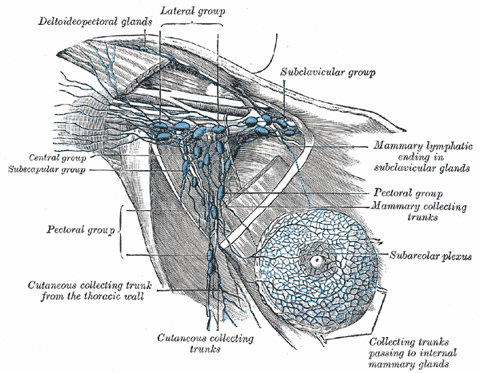A tumour can spread from its original site via the lymphatic drainage system to regional lymph nodes. The aim of this operation is to remove the regional lymph nodes in your armpit, along with the surrounding fatty and connective tissue, and any tumour which has developed in them.

The operation is performed under general anaesthetic which means you will be fully asleep during the entire operation. The anaesthetist will see you before your operation so you can discuss any queries you may have about the anaesthetic.
If you have had any difficulties during a general anaesthetic in the past, make sure both the anaesthetist and the ward doctor are aware of them
After Your Operation
On the evening after your general anaesthetic you will feel rather tired and sleepy and should warn your visitors that you may not be very good company!
When you come back from the operating theatre you will have a small needle in your arm or hand attached to a drip. This will stay in until you are eating and drinking normally - usually just overnight.
You will also have drains in your wound to drain any fluid from the wound. These stay in until they stop draining. Sometimes these drains need to be left in for a long period of time but usually the draining will eventually stop.
You will have a curved scar across your armpit.
Any operation can give problems with infection or bleeding. Simple infections will settle through treatment with a course of antibiotics but some infections go on to form an abscess which may need a further operation.
If you notice increasing redness of your wound or it is painful, tell a doctor as soon as possible as infections caught early are easier to treat.
Bleeding after your operation may result in a collection of blood in the wound called a haematoma. If this happens you will need an operation to drain the haematoma or it may cause problems with the wound later on.
It is common to have swelling in your arm called lymphoedema after an axillary dissection. This is due to the disruption of the lymph vessels which carry lymph fluid from the arm across the armpit. Sometimes it is necessary to learn to massage the fluid out of your arm and if lymphoedema is a problem for you, you can ask to be referred to our specialist team who can teach you this technique. If this is not enough to control the swelling you may need to wear a firm stocking during the day.
Any infections of the arm or hand must be treated promptly as severe infections can develop rapidly in an arm with lymphoedema. If you go into hospital in the future, it is important to remind the staff not to put a drip into that arm unless it is absolutely necessary to prevent your lymphoedema being made worse.
Going Home
Once your drains have been removed and you are up and about and feeling well you will be able to go home. You may be sent home with your drains in and the nursing team will inform you about what to do with them.
Before you leave the ward you will be given an appointment for the dressing clinic. Any stitches you have will be removed at this appointment and your wound will be checked and your dressing changed. You will also be given an outpatient clinic appointment.At first you will feel rather tired and you should spend the first week or so taking it easy. After that you will be able to slowly build up to doing your usual activities.
Driving
You will be able to start driving once you feel up to it and you are able to perform an emergency stop comfortably. For most people this will take about four weeks. Do not drive if you are not well, alert and able to take emergency action. It is advisable to check with your insurance company before you start driving again.
Driving
You will be able to start work again once you feel up to it but if your job involves a lot of lifting or heavy work this will take longer. Speak to your GP who will give you a sick certificate to cover you until you are fit to go back to work.





